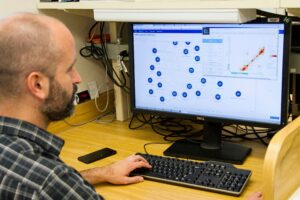
From unique wildlife to resilient microbes, world-changing climate dynamics to untapped biotechnological potential, Antarctica stands as a scientific frontier like no other. This remote, icy continent is not just a barren expanse but a vibrant laboratory that continues to intrigue scientists worldwide. Four researchers from UNSW Sydney have shared insights into why this icy wilderness is crucial for scientific exploration.
Earlier this year, Christina Schmidt, a PhD candidate at UNSW Sydney, submitted her thesis from aboard Australia’s multi-billion-dollar icebreaker, RSV Nuyina, while stationed off the East Antarctic coast. Her research focuses on Antarctic Bottom Water, a cold, dense water mass essential for Earth’s deep ocean circulation. However, her journey was more about gaining firsthand experience in one of the planet’s most challenging environments.
The Denman Marine Voyage: A Scientific Endeavor
In the weeks leading up to her thesis submission, Schmidt traveled thousands of kilometers across the Southern Ocean from Hobart to Antarctica. She was among 60 scientists on the RSV Nuyina’s Denman Marine Voyage, a pioneering expedition exploring the Denman Glacier, the fastest-retreating glacier in East Antarctica. This mission marked the icebreaker’s first full-scale marine science operation, equipped with advanced laboratories and sonar systems.
Schmidt’s role involved conducting titrations to measure chemical concentrations in seawater, assisting the hydrochemistry team in analyzing oxygen levels from a shipping-container lab. The nearly two-month-long, 24/7 operation was a collaboration between Australia’s major Antarctic research organizations, including the Australian Antarctic Program and the Australian Centre for Excellence in Antarctic Science.
“Every day there was something new: penguins waddling across the floes, or a jade green iceberg – which I’d never seen before,” Schmidt recalls, describing her first days at the Denman Glacier as among the best of her life.
Antarctica: A Barometer for Earth’s Future
Antarctica’s extreme climate and fragile ecosystems make it a challenging yet vital area for research. The Southern Ocean, encircling the continent, is known for its brutal winds and harsh conditions. However, these very features make Antarctica a critical barometer for understanding Earth’s future. Its ice sheets significantly impact sea levels, while the Southern Ocean influences global climate systems.
The RSV Nuyina’s recent ability to access new sites was partly due to dramatically reduced sea ice, a concerning indicator of climate change. “The sea ice cover when we were there was 70% lower than average,” Schmidt notes, highlighting the environmental shifts occurring in the region.
Sea ice is crucial for various species, including krill, seals, and penguins. In the Bellingshausen Sea of West Antarctica, low sea ice levels led to a catastrophic breeding failure for Emperor penguins, with chicks perishing before developing essential survival skills.
Exploring the Microbial Mysteries
Professor Belinda Ferrari, an environmental microbiologist at UNSW, has spent over a decade investigating the secrets hidden in Antarctica’s ice-free soils. Despite covering only 0.3% of the continent, these areas hold immense ecological and scientific value. Prof. Ferrari’s research has uncovered at least 20 new microbial species, some potentially harboring antifreeze proteins or novel antibiotics.
“They scavenge on hydrogen and carbon monoxide,” Prof. Ferrari explains, describing microbes that survive without sunlight through atmospheric chemosynthesis.
These discoveries have implications beyond Antarctica, with potential applications in understanding life’s limits on Earth and other planets. Collaborating with NASA, Prof. Ferrari’s work could inform models of Martian life, given the unique survival strategies of Antarctic microbes.
Biotechnological Frontiers and Remote Research
Alinta Furnell, a former honours student of Prof. Ferrari, ventured into biotechnology with her research on Antarctic fungi. Her work revealed the fungus’s genetic potential for producing novel compounds, including mycosporine-like amino acids used in sunscreens. This research underscores the practical applications of Antarctic discoveries in biotechnology.
Meanwhile, UNSW Professor Tracey Rogers highlights the challenges of conducting field-based research in Antarctica. The logistical complexities and high costs limit opportunities for direct study, prompting researchers to diversify their methods and collaborate with tourism industries for access to wildlife-rich areas.
“In my 30-year career, the hit rate for getting out in the field was one good year out of three,” Prof. Rogers reflects, emphasizing the need for adaptive research strategies.
The Path Forward: Collaboration and Innovation
Antarctica remains a land of enduring mystery, binding Earth’s past, present, and future through its glaciers, wildlife, and hidden genetic treasures. For Christina Schmidt, the journey continues with a postdoctoral role in Greenland, modeling glacier melt. For Prof. Ferrari, the focus remains on mapping life’s limits on Earth and beyond. Alinta Furnell translates biology into biotech solutions, while Prof. Rogers guides students through the evolving landscapes of Antarctic research.
Reflecting on her expedition, Schmidt emphasizes the importance of collaboration in Antarctic science. “It works best when people are willing to collaborate across disciplines and backgrounds,” she asserts, underscoring the cooperative spirit necessary for advancing knowledge in this remote frontier.
As Antarctica continues to reveal its secrets, the scientific community remains committed to unlocking its potential for understanding our planet and beyond.







